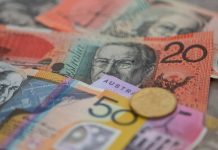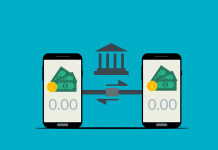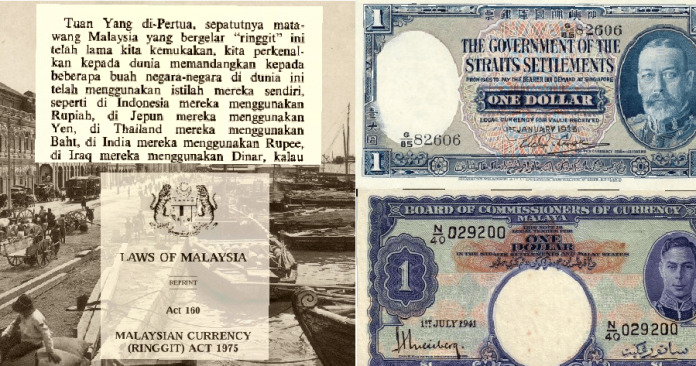Have you ever wondered why our currency is called ‘Ringgit’? In fact, did you know that prior to 1975, Malaysia’s official currency is actually called the Malaysian Dollar?
Furthermore, we only started officially using the ‘RM’ symbol in December 1992. Prior to that, the symbol was actually M$. So, why the change?
Well let’s dive into the history books, Parliament official records and Malaysian Parliamentary Act 160 together to find out.
1. How the Malaysian Dollar came to be our currency post-Merdeka

1 Straits Settlement Dollar in 1935| Source: Wikipedia
The use of the currency ‘Dollar’ as the most widely used currency in Peninsular Malaysia or Malaya at the time can be traced back to the Straits Dollarisation by the Board of Commissioners of Currency for the Straits Settlements in 1897.
For those of you who need a refresh of Malaysian history, the Straits Settlements were territories unilaterally controlled by the British East India Company in Southeast Asia which comprised of:
- Penang
- Singapore
- Melaka
The Straits Settlements came under rule by the British Empire on 1 April 1867.

The Penang Port circa-1910 under the Straits Settlements | Source: Wikipedia
According to the Monetary Authority of Singapore (MAS) in its Macroeconomic Review Volume XVI, Issue 1, the Board of Commissioners of Currency for the Straits Settlements issued official currency notes and minted silver dollars for the territories under the Straits Settlements.
The currency was known as the ‘Straits Dollar’.

The Straits Cent in 1920 | Source: Wikipedia
Given that British practically ruled the whole of Malaya, Singapore and North Borneo at the time – whether directly or indirectly -, the Straits Dollar was also circulated in these parts too and not just in the Straits Settlements.
During that time, Sabah used the currency known as the British North Borneo Dollar while Sarawak under Brooke rule used Sarawak Dollar. Both were exchangeable at par with the Straits Dollar.

The City of Brunei circa 1844 | Source: Britishempire
Hence, the Straits Dollars became the de facto currency of Malaya, Singapore and North Borneo at the time due to its ubiquitous circulation and acceptance.
Fast forward to 1938, the British through the Currency Ordinance 1938 created a common currency for these territories:
- The Straits Settlements.
- The Malay States in Malaya.
- Brunei which became a British Protectorate in 1888.
Thus the ‘Malayan Dollar’ was created.


The Malayan Dollar in 1941 | Source: Wikipedia
7 year later however, Malaya became under the occupation of Japan during World War II which disrupted this Ordinance. In 1950, it was revived to include North Borneo (Sabah) and Sarawak and the governing board was renamed to the Board of Commissioners of Currency Malaya and British Borneo.
Forward another 7 years, Malaya gained independence and subsequently established Bank Negara Tanah Melayu in 1959.
In 1964, one year after Malaysia was formed, a “notice of replacement” was sent to the Board of Commissioners of Currency Malaya and British Borneo which was still the official authority on currency circulation at that time. Afterwards, Malaysia began issuing its own currency beginning from December 1966.
Therefore, the Malaysian Dollar was created.

The Malaysian Dollar. Note that it is printed as ‘ringgit’ but called dollar | Source: Lunatic
Wait, so where was ‘ringgit’ in all of this? Well, carry on reading below!
2. The use of the word ‘Ringgit’ and its history
According to Merriam-Webster, the first recorded use of the word ‘Ringgit’ was in 1894. The word itself, according to our Dewan Bahasa dan Pustaka means “gerigi” or translated to English to mean “serrations” found on edges of steel.

Upon researching its etymological history, the Independent defined Ringgit originating from,
“When coins were minted in precious metals, thieves would shave off small portions of the metal to create new coins. To combat this, countries began minting coins with jagged edges. The Malaysian word for jagged is “ringgit,” the name of the currency.”
Furthermore, according to Sim Ewe Eong in the
Journal of the Malaysian Branch of the Royal Asiatic Society Vol. 47, No. 1 (225) (1974), it was originally used to refer to the serrated edges of silver Spanish dollars which circulated widely in Peninsular Malaysia during the Portuguese rule in our country.

A silver Spanish dollar minted in Mexico City c. 1650 | Source: Wikipedia
The word is then adapted into the Malay language to mean money and was used unofficially and colloquilly to refer to the Malaysian Dollar. In fact, even in the Parliament Hansard or official records, Member of Parliament has been calling Malayan Dollar as Ringgit in the Dewan Negara as early as 1959.
3. Why the Malaysian Government changed the name from Dollar to Ringgit

The Malaysian Currency (Ringgit) Act 1975 | Source: AGC
The Malaysian Dollar officially became the Malaysian Ringgit on 28 August 1975 through the MALAYSIAN CURRENCY (RINGGIT) ACT 1975 which can be found here.
In summary, the above Act, which is Act 160 prescribed that:
- The Central Bank of Malaysia Act 1958 is amended to make Ringgit the currency of Malaysia.
- The Ringgit currency will be divided into one hundred sen each.
- All transactions made with Malaysian Dollar will be substituted with Malaysian Ringgit.
- The word “dollar” to be subsituted with “ringgit” and “cents” with “sen”.

The Malaysian Currency (Ringgit) Act 1975 | Source: AGC
So why did the Malaysian government introduced Act 160 to change Dollar to Ringgit? For that, we have to check the Parliamentary debate on the bill.
After scouring through the Parliament Hansard, I’ve found the proposal of the bill and its subsequent discussion on Monday, 28 July 1975 in the Dewan Negara. You can download and read it here if you’re interested.

Parliament Hansard on 28 July 1975 | Source: Parlimen Malaysia
Proposed by Tan Sri Chong Hon Nyan, then Member of Parliament for Batu Berendam, Melaka and Deputy Finance Minister at that time, here’s a summary of why the bill was introduced:
- To officially and legally recognize to the words “ringgit” and “sen” when referring to the unit of Malaysian currency.
- The word is ubiquitously used by Malaysians hence it’s time for the Bank Negara Ordinance to also recognize it.
- This legal change will establish confidence of Malaysian currency and refine its image globally.
- To make the world recognize Malaysia as a country as many in the world knows only of Singapore and not Malaysia, hence the change to ringgit will announce ourselves to the world. This was argued by Tuan Haji Ibrahim bin Haji Yaacob.
- Meanwhile, Tuan Haji Othman bin Abdullah supported the idea and said we should’ve changed it to Ringgit a long time ago and followed the footsteps of Indonesia, Thailand, Japan and Saudi Arabia to introduce our own currency.

Excerpt from the Act 160 debate | Source: Parlimen Malaysia

The late Tan Sri Chong Hon Nyan | Source: The Star
The bill was then agreed upon and made into a Federal Gazette. On 1 December 1992, Bank Negara Malaysia reported that the official symbol of the Malaysian Ringgit changed from M$ to RM.
The abbreviation RM (or Ringgit Malaysia) would apply to both Bahasa Malaysia and English version to differentiate with Brunei Ringgit.
Thus that is the history of how we changed from the Malayan Dollar to the Malaysian Ringgit.
This blog post was originally published in World Of Buzz on 26 July 2020.
Do catch us on:
Web: https://cashchanger.co | https://remit.cashchanger.co/
Telegram: https://cashchanger.co/telegram
Facebook: https://fb.me/cashchanger
Instagram:https://www.instagram.com/cashchangercom/


























